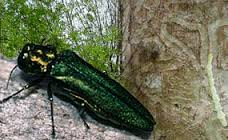
DES MOINES – Emerald ash borer (EAB) has been positively identified in a residential tree in the southeast corner of rural Dallas County, making Dallas the 21st county in Iowa where this invasive beetle has been found. EAB kills all ash tree species and is considered to be one of the most destructive tree pests ever seen in North America.
EAB has now been identified in two counties adjacent to Greene County. EAB was identified in Boone County last August.
The current EAB infestation was found as a result of an arborist contacting state officials about a suspect ash tree. Investigation by the Iowa EAB team revealed characteristic galleries, recent woodpecker activity, and live larvae that were positively identified by federal identifiers.
“With this discovery, Iowa has declared three positive counties in 2015 where this ash-killing pest has been found,” said Mike Kintner, Iowa Department of Agriculture & Land Stewardship’s EAB and gypsy moth coordinator.
Twenty-one Iowa counties now have confirmed EAB infestations. A statewide quarantine, issued on Feb. 4, 2014, remains in place, restricting the movement of hardwood firewood, ash logs, wood chips and ash tree nursery stock out of Iowa into non-quarantined areas of other states.
“We still strongly urge Iowans to not move firewood long distances,” said state entomologist Robin Pruisner of the Iowa Department of Agriculture and Land Stewardship (IDALS). “A large portion of Iowa is not showing signs of EAB infestation; let’s keep those areas EAB-free as long as possible by not moving wood that potentially harbors EAB or other tree pests. Be vigilant and report suspicious symptoms in counties that are not yet known to be infested to a member of the Iowa EAB team.”
The Iowa EAB Team provides EAB diagnostic assistance to landowners and includes officials from Iowa IDALS, Iowa State University Extension and Outreach, the Iowa Department of Natural Resources (DNR), USDA Animal Plant Health Inspection Service and the USDA Forest Service.
The window for preventive treatment measures (trunk injection, soil injection, soil drench or basal trunk sprays) is mid-April to mid-May. If a landowner is interested in protecting a valuable and healthy ash tree within 15 miles of a known infestation, they should have landscape and tree service companies bid on work, review the bids and treat during the recommended treatment time.
Please contact Iowa EAB team members to have suspicious looking trees checked in counties not currently known to be infested. The state of Iowa will continue to track the movement of EAB on a county-by-county basis. Before a county can be officially recognized as infested, proof of a reproducing population is needed and an EAB must be collected and verified by USDA entomologists.
To learn more about EAB and other pests that are threatening Iowa’s tree population, please visit www.IowaTreePests.com.
